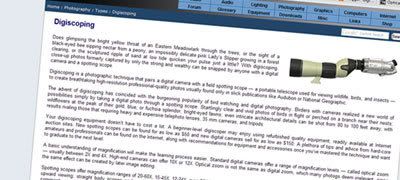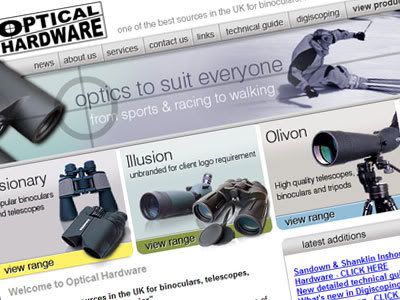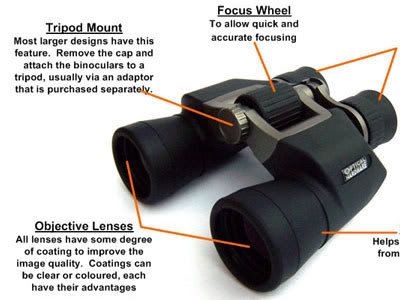Fundamental Digiscoping Equipment
1. digital camera
2. spotting scope
3. sturdy tripod
4. camera - scope adapter
5. cable release
6. bracket
There are only 6 fundamental equipment that you need to get you into digiscoping. Just refer to the list above.
Digital camera.
Almost any digital camera will do but I suggest point-and-shoot with 3x - 4x optical zoom and a small diameter lens. The widely used camera previously are Nikon Coolpix 990, 995, 4500, P4, P5000 and P5100 . The other cameras which suits digiscoping are Olympus C7070. Make sure you have a few memory cards of large capacity like at least 1GB. Believe me, you need it because this hobby can be very addictive especially if you click on burst or continuous mode. Sometimes, you may even switch to movie mode and that will take more spaces on the memory card. So, carry a few with you since nowadays the cards are more affordable than a few years ago. Also, carry along some spare batteries. I have a Nikon Coolpix 4500 and a Casio QV-2900UX. My wife's Sony-Ericsson K810i with a 3MP camera works but quality suffers.
Spotting scope.
What is digiscoping without a spotting scope? There are many brands and models in the market. So, pick yours wisely. In my experience, buy a decent scope and try to avoid the cheap scopes. Do more research of a particular scope that you are interested in. Buy one that you can afford and do not burn a hole in your pocket. I am not asking you to buy the top range like Swarovski, Leica, Zeiss or Kowa but if you can afford it, why not? But if you are like me, who does not have much money to dispose, get a scope that do not have problem of chromatic aberration (purple fringe on subject). But if the issue is minimal it can be corrected later when processing the picture on the computer with photo editing software like Adobe Photoshop. I am using a Nikon Spotting Scope 65mm RAII(A) a.k.a. Nikon Sky and Earth 65mm with a 25x fixed eyepiece.
Sturdy tripod.
You really need a sturdy tripod. Why? Simply because a scope with the camera attached is not anything like a feather's weight. You have to buy a good tripod with a video head. I am using a Manfrotto tripod and video head based on Laurence's recommendation before I join the digiscoping circle.
Camera - scope adapter.
You can buy a universal adapter that fits any camera in case if you upgrade camera often. Like I said, things are cheaper as compared to last few years. Better get a universal adapter and get a light unit. Well, you can also hand held the camera on the eyepiece but make sure your hand does not shake.
Cable release.
I can't remember how much I pay for the cable release, but I know one of my cable comes along with the bracket that I ordered from Mr.Cheang who customize bracket and adapter. The cable does not cost much compared to other equipment. You will need this cable to minimize hand shake when pressing the shutter button on your camera.
Bracket.
A bracket is useful when you use a cable release to take pictures. You need this one. Somehow, some new camera - scope adapters are fitted with a cable release bracket.
Okay, I have finish with the fundamental equipment. The next thing you need is to process the pictures on the computer.
But before I continue with the next chapter, if you think what I am sharing with you are useful, feel free to make donation for the information and experiences that are displayed on this site. With your generous gift, I will be able to continue spread the hobby of digiscoping.
Click the donate icon below to contribute so that I can continue doing research on digiscoping. This is to ensure that you appreciate my time and effort on introducing digiscoping.










 The "9 series" range started back in 1998 with the 1.2 megapixel, 3x zoom, Nikon Coolpix 900 (E900), soon to be followed by the updated 900s (E910) this was the first time we saw the swivel design and also opened peoples eyes as to what a digital camera was capable of. I admit my first (real) digital camera was a Nikon Coolpix 900s.
The "9 series" range started back in 1998 with the 1.2 megapixel, 3x zoom, Nikon Coolpix 900 (E900), soon to be followed by the updated 900s (E910) this was the first time we saw the swivel design and also opened peoples eyes as to what a digital camera was capable of. I admit my first (real) digital camera was a Nikon Coolpix 900s. In 1999 came the 1.92 megapixel, 3x zoom, Coolpix 950, a completely re-engineered camera of a quality over and above what we'd seen in the 900. It was well received by reviewers and owners alike, despite some shortcomings (chromatic aberrations and a few non-ergonomic functions) it soon became the de facto 2 megapixel digital camera (and is still used for comparison purposes today). Many other 2 megapixel digital cameras came, despite some very close competition (Olympus C-2000Z & C-2020Z) the Coolpix remained the favourite prosumer digital camera.
In 1999 came the 1.92 megapixel, 3x zoom, Coolpix 950, a completely re-engineered camera of a quality over and above what we'd seen in the 900. It was well received by reviewers and owners alike, despite some shortcomings (chromatic aberrations and a few non-ergonomic functions) it soon became the de facto 2 megapixel digital camera (and is still used for comparison purposes today). Many other 2 megapixel digital cameras came, despite some very close competition (Olympus C-2000Z & C-2020Z) the Coolpix remained the favourite prosumer digital camera. In 2000 we saw the 3.14 megapixel, 3x zoom, Coolpix 990. Not just a step forward in resolution the 990 had improved ergonomics, better build quality and a raft of new "prosumer" features which delighted both Coolpix aficionado's and new buyers alike. The 990 saw the introduction of the 5-area spot AF, focus confirmation, a new aperture diaphragm, USB connectivity, sharpness control, histogram and highlighting, fine tuneable white balance and many more. The 990 soon established itself as the top 3 megapixel consumer digital, the one all other manufacturers aimed to beat.
In 2000 we saw the 3.14 megapixel, 3x zoom, Coolpix 990. Not just a step forward in resolution the 990 had improved ergonomics, better build quality and a raft of new "prosumer" features which delighted both Coolpix aficionado's and new buyers alike. The 990 saw the introduction of the 5-area spot AF, focus confirmation, a new aperture diaphragm, USB connectivity, sharpness control, histogram and highlighting, fine tuneable white balance and many more. The 990 soon established itself as the top 3 megapixel consumer digital, the one all other manufacturers aimed to beat. 2001 brought us the 3.14 megapixel, 4x zoom, Coolpix 995. Seen by many as an interim camera the 995 also stepped away from the 990's clean design to an arguably uglier and more complicated design. The 995 introduced several new features such as support for Compact Flash Type II (although not officially the IBM Microdrive) as well as the pop-up flash and a 4x optical zoom lens (which did come in for criticism by some). This evolution also saw the lens portion of the body changed from metal to plastic, again not a popular move with Nikonians.
2001 brought us the 3.14 megapixel, 4x zoom, Coolpix 995. Seen by many as an interim camera the 995 also stepped away from the 990's clean design to an arguably uglier and more complicated design. The 995 introduced several new features such as support for Compact Flash Type II (although not officially the IBM Microdrive) as well as the pop-up flash and a 4x optical zoom lens (which did come in for criticism by some). This evolution also saw the lens portion of the body changed from metal to plastic, again not a popular move with Nikonians.